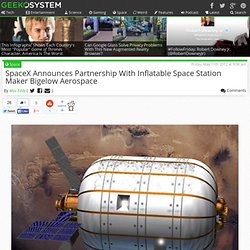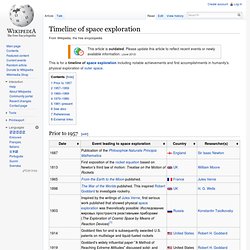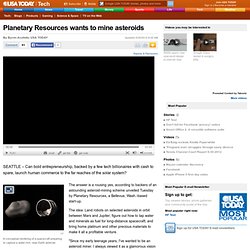

A&D_Overview_Indian_Space_Sector2010. SpaceX Announces Joint Inflatable Space Station Plans. A little over a week before SpaceX’s planned unmanned mission to the International Space Station, the company has announced a new partnership with Bigelow Aerospace, makers of inflatable habitats for space.

Though the deal may sound far-fetched, its a sign that the commercial space industry is maturing quickly an has an eye on the future. The deal was announced yesterday in a SpaceX press release, where the two companies said that they would begin a worldwide joint marketing campaign. While “inflatable space station” sounds like a completely bonkers idea, it was actually developed by NASA and acquired by Bigelow in the 1990s. According to their website, their inflatable habitats offer as much protection against high-velocity impacts and radiation as traditional solid aliminum design, while offering more space at a fraction of the weight. And of course, when launching into space, weight is everything. The company’s founder Robert T. (via SpaceX) How much money is spent on space exploration? What countries are involved in space exploration.

And how much money of the United States Budget, and the top 5 other countries' budgets are being used for space exploration. Space agencies involved in human space flight are located in the US (NASA), Russia, The European Union (ESA), China, Canada, Japan and India. The US, Russia and China are the only countries to have independently put people in space. India and Japan state that they have the intention of doing this in the coming decades. Google Image Result for. Lunar eclipse: US retreat leaves China leading way in race to return to moon. Chinese astronauts (left to right) Jing Haipeng, Zhai Zhigang and Liu Boming wave in the cabin during a training mission in 2008 at the satellite launch centre in Jiuquan, Gansu province.

Photograph: AP The Chinese space agency could land its first astronauts on the moon within a decade in a move that would mark the beginning of a new age of lunar exploration, experts said today. The decision by the Obama administration to scrap Nasa's plans to return to the moon leave China well placed to become the second nation to land humans on the lunar surface.
"The moon is an obvious target for China and they could be there in 2020," said Ken Pounds, professor of space science at Leicester University. The US president's budget proposal, unveiled on Monday, lacked the funds to sustain Nasa's $81bn Constellation programme, the spaceships and rockets designed to put humans back on the moon by 2020. Timeline of space exploration. This is for a timeline of space exploration including notable achievements and first accomplishments in humanity's physical exploration of outer space.

Prior to 1957[edit] 1957–1959[edit] 1960–1969[edit] 1970–1980[edit] 1981–present[edit] 1Project Vanguard was transferred from the NRL to NASA in late 1958. See also[edit] References[edit] External links[edit] Chronology of Space Exploration archive of important space exploration missions and events, including future planned and proposed endeavors. Planetary Resources wants to mine asteroids. SEATTLE – Can bold entrepreneurship, backed by a few tech billionaires with cash to spare, launch human commerce to the far reaches of the solar system?

The answer is a rousing yes, according to backers of an astounding asteroid-mining scheme unveiled Tuesday by Planetary Resources, a Bellevue, Wash. -based start-up. The idea: Land robots on selected asteroids in orbit between Mars and Jupiter; figure out how to tap water and minerals as fuel for long-distance spacecraft; and bring home platinum and other precious materials to make it all a profitable venture. "Since my early teenage years, I've wanted to be an asteroid miner. I always viewed it as a glamorous vision of where we could go," Peter Diamandis, the visionary behind Planetary Resources, told a news conference at Seattle's Museum of Flight.
The project is on a fast track. Other key investors include Google CEO Larry Page and Executive Chairman Eric Schmidt. Contributing: Scott Martin, The Associated Press. Asteroid mining plans revealed by Planetary Resources, Inc. « Futuretimeline.net. Planetary Resources, Inc. announced today its plan to mine Near-Earth Asteroids (NEAs) for raw materials, ranging from water to precious metals.

By developing cost-effective exploration technologies, the company aims to initiate prospecting missions targeting resource-rich asteroids that are easily accessible. Mining from asteroids could deliver huge benefits to humanity – potentially adding trillions of dollars to global GDP. Asteroids are rich in resources, and these could provide a sustainable supply to the ever-growing population on Earth.
A single 500-metre platinum-rich asteroid contains the equivalent of all the Platinum Group Metals mined in history. “Many of the scarce metals and minerals on Earth are in near-infinite quantities in space. Additionally, water-rich NEAs could serve as “stepping stones” for deep space travel, providing fuel and water to orbiting depots. It's Official: James Cameron and Google Unveil Plans for Asteroid-Mining.